Gingham fabric has been around for a long, long time. Since the early 17thcentury to be exact, although the look of the fabric has changed considerably since those days. The word “gingham” is from a Malay word “gingang” which means “with space between,” hence, striped. Yes, originally gingham was a striped fabric. It appears that it became a checked fabric sometime in the mid 1700s, and of course, that is how we think of it today.
Gingham has a fresh, timeless appeal to it, and the iterations of it are countless. The size of the checks can be absolutely miniscule or large and prominent.
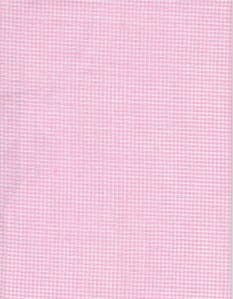
Each check in this gingham is only a couple of threads wide. I do not have an example of a really large checked gingham, but you can surely visualize it.
There are two types of gingham; the entry in The Fairchild Dictionary of Fashion (Third Edition, by Charlotte Mankey Calasibetta and Phyllis Tortora; Fairchild Publications, Inc., New York, New York, c2003, page 209) explains it beautifully: “Checked ginghams are two-colored effects made by using two colors, or one color and white, for groups of yarns in both the lengthwise and crosswise. Plaid ginghams are yarn-dyed designs of several colors.”
And do you know what zephyr ginghams are? “Zephyr ginghams,” according to Fairchild’s “are made with fine, silky, mercerized yarns.” Obviously both checked and plaid ginghams can be zephyr ginghams.
And indeed, it was a zephyr plaid gingham which I used for my most recent blouse:
I purchased this fabric at the same time I ordered the fabric for my lavender gingham blouse. I still had the “blouse bug,” so I decided to go for it! I made a few tweaks to the pattern; specifically I added a tapered half inch to the lower half of the sleeves, to give me a little more ease in rolling them up. Of course, this meant I needed to add a half inch to the diameter of the cuffs. I also increased the length of the sleeve vent by about 1.25 inches. I find these changes just add a bit more finesse to the wearing of this blouse, which is super comfortable anyway.

I kept the center back pleat, as it just makes this blouse so comfortable to wear, especially on a hot summer day.
Now, do you see that double navy blue line at the center front?
That is a mistake. I thought I had calculated the grid of the plaid correctly to have a continuous pattern across the front of the blouse. About halfway through its construction, I discovered I had calculated incorrectly. At that point I did not have enough fabric left over to cut out two – or even one – new fronts, so my fate was sealed. Now I know what I did wrong, and hopefully I won’t make that mistake the next time I make a gingham blouse. (And there will be a next time, but probably not this year.)
Being a button aficionado, I of course searched again for the right buttons for this blouse. I thought about using these vintage pearl buttons with their square motif. However, at 5/8” wide, they were just too big.
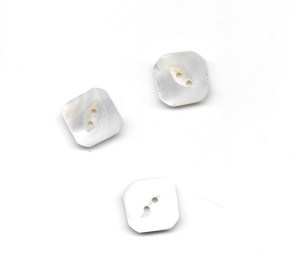 I finally admitted to myself that buttons on a blouse like this should not be the focal point; they should be delicate and discreet – which led me to this card of vintage buttons in my collection:
I finally admitted to myself that buttons on a blouse like this should not be the focal point; they should be delicate and discreet – which led me to this card of vintage buttons in my collection:
The luminosity of the pearl in these buttons actually picks up the pink in the plaid in a very subtle way – and they are definitely discreet.
Well, I don’t want to end this post without giving you a few more fun facts on gingham. Did you know that “gingham” was a colloquial term for an umbrella in the 19thcentury? Again, according to Fairchild’s Dictionary (page 462), “so called because the less expensive types were made out of gingham fabric.”
And who doesn’t know that Dorothy Gale in The Wizard of Oz wore a blue gingham dress? Or that Brigitte Bardot wore a pink gingham wedding dress (which led to a shortage of this fabric in France, according to Wikipedia)?
If you have not recently read the classic poem by Eugene Field (1850-1895), “The Gingham Dog and the Calico Cat,” it might be time to reacquaint yourself. Here is how it starts: “The gingham dog and the calico cat, side by side on the table sat.” Just the mention of the fabrics creates a mental picture of what is to ensue between these two!
There are few fashion references to gingham that are noteworthy, save for this one from interior designer Kelly Wearstler, “The best thing I ever bought is a vintage Oscar de la Renta short gingham dress that I wore to my rehearsal dinner the night before my wedding.”
And finally, this from Christian Dior on “checks” (The Little Dictionary of Fashion, by Christian Dior, Harry N. Abrams, New York, New York, 2007, page 21): “I love checks. They can be fancy and simple; elegant and easy; young and always right…. They are always in fashion … and there are so many styles of checks to choose that there will be one to suit every age and figure.”
From “always right” cotton gingham, I now head to another “always right,” forever, classic motif: polka dots – in silk! New month, new project. Happy July, everyone!

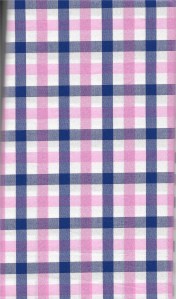

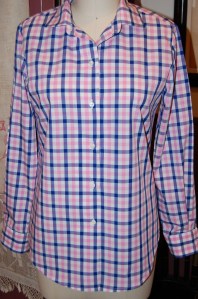
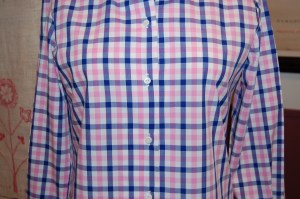
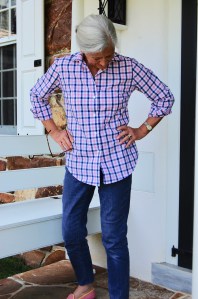
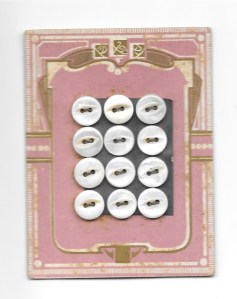
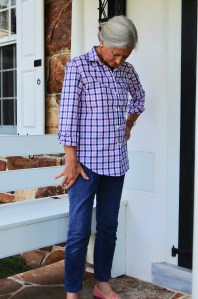



Oh, I think I can imagine that sinking feeling having an unintended design feature front row and center! Nevertheless, your blouse is wonderful! I had similar button musings just a couple of days ago and had the same problem–the ones I wanted to use were too big, I had to admit. However, this is where a stash is such an asset; I found more buttons I hadn’t considered at all before, and I think they will do very well. Maybe even better. I love checks, and have made draperies in a big buffalo check I enjoy every day. How can checks be so classic and yet so fresh? Looking forward to your polka dot project.
Yes, I was quite irritated with myself when I realized what I had done. Of course, it’s not the end of the world, and this experience will no doubt make me keenly on task next time I am matching plaids! I so agree about checks – they never fail to please my eye and my mood!
Beautiful checked blouse! You didn’t mention which pattern you used? It has a nice french dart and I like the back as well.
Thanks, Kathleen. I used a vintage 1970 Simplicity pattern which somehow I managed to save from my “younger” days. It is the same pattern which I used for my lavender checked blouse. I added the back darts, and it actually does not have any bust darts, but the side seams are nicely shaped to compensate for no darts.
Lovely work as always. And a great read to boot!
Thanks! I’m glad you enjoyed reading it!
Thank you for such an interesting post. I love this blouse when more than the last. I didn’t know about different types of gingham but have a preference for this type.
So happy to know you found this post interesting, Ann!
As much as I e joy your couture dresses and girls dresses I really need right now to see this better sportswear because that’s what I most need to update. It is so you with its pink focal point in back, and the blue lines in front looking like a planned visually elongating connector from jeans to eyes. With the sleeves easier to roll up it’s now the perfect, flattering shirt pattern. I am glad for you.
Thanks, Mery! I will definitely be using this pattern again, especially now that I have the kinks ironed out of it! I love to make the fancy things and the little girls’ dresses, but I agree – it is the sportswear, everyday attire which I really need to make. Of course, that said, I am now gearing up for more of the fancy… Hmmmmm!
I honestly didn’t notice the 2 blues until you pointed it out! Very nice.
Thanks, Heather! That makes me feel better!
This was such an interesting post; not only the quotes and history of gingham, but also how you made it perfect for you. I didn’t even notice the double blue lines until you told us and then I was able to notice the buttons more! I do nave 2 questions….. how do you make a “spread” collar and what is your pattern? I always look forward to your posts! Keep ’em coming 🙂
Thank you, Mary Lynn. I used a vintage 1970 Simplicity pattern which somehow survived many moves and de-cluttering sessions over the past 40-some years. It is the same pattern I used for my lavender gingham blouse. I made this collar into a spread collar by cutting off (on an angle) the sharp points on the pointed collar which is original to the pattern. I give a bit more information on this in my post on the lavender checked blouse.
Yes, which pattern did you use for this? And, if you get tired of that blouse, I would be happy to take it off your hands…just exactly the kind of blouse I love! 😉
You probably saw in the other comments that I used a 1970 simplicity pattern for the blouse, same one I used for the lavender checked blouse. I made numerous changes to it, but the bones of that pattern are quite solid!
I wish I still had some of my old patterns! There was one shirt in particular that was such a perfect basic….oh well!
I love learning new and interesting facts about history including fashion and where it comes from! Well researches and presented! I love the part about “Brigitte Bardot wore a pink gingham wedding dress (which led to a shortage of this fabric in France, according to Wikipedia)?” I NEED to know this stuff! It fills me with a giddiness about how fickle we can be about some trends! While others we find just classic and timeless! For example your pink shoes! Timeless! ❤ Your new shirt, classic! ❤
Thank you so much, Danita! So much fashion history is so interesting, I think. I love to read about it and I’m glad you do, too!
Your blouse is lovely. I’ll bet you were really annoyed with yourself when you realised your miscalculation. I don’t think anyone would notice unless you pointed it out. The cut and the drape make it look very comfortable and easy to wear. X
I was SO annoyed, Karen! At first I couldn’t believe it, as I had given that section considerable thought, and I was sure I had it lined up correctly. I started looking at some RTW blouses and some of my husband’s shirts and started seeing numerous glitches in pattern matching. I can’t say that made me feel better, but it did give me some perspective through which to view this. Fortunately, my mistake will not keep me from wearing this blouse!
Nice blouse.
Thank you, Liselotte!
Beautiful blouse! When I’m nervous about matching a pattern at the front of a shirt, I make a bias cut placket. Then I get an interesting design feature, and I don’t have to worry about lining things up perfectly.
I actually wasn’t nervous about matching that front opening – I thought I had it placed correctly! After finding my mistake, I considered adding a front placket, but that was not the look I wanted. So – I’ll just have to live with my mistake, but thank you for your advice, Sarah!
Thank you for the interesting facts about gingham. And, gingham does seem to have a timeless yet fresh quality to it. Your new shirt shows that and suits you so well. Hope you are staying cool in this Main Line heat.
Thank you for your post.
You’re welcome, Debra! Glad you enjoyed reading about gingham! Whew – it IS hot, isn’t it? Best to stay indoors and sew, wouldn’t you agree?
Thank you for this interesting read about gingham. I must admit I had never heard the word before I started reading sewing blogs in English! The fabric of Brigitte Bardot’s wedding dress is known in Europe as Vichy checks, or
simply Vichy. In the sixties the pink variety was often referred to as Bardot or BB checks and it was my favourite fabric at the time. I love your blouse and am jealous of how you can even make little mistakes look stylish!
This is so interesting, Marianne. I saw a reference to Vichy checks when I was doing some research into gingham, but I had no idea that the word “gingham” was not universal! At this point I am already looking forward to making my next gingham blouse – sometime!